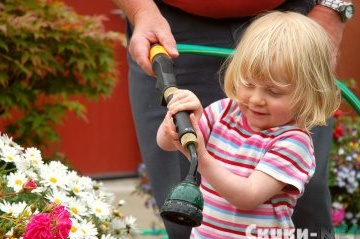Without water, a plant cannot grow and bear fruit. Water is necessary for the growth and reproduction of cells and tissues. It is part of all plant organs. Water is an active participant in the process of photosynthesis. Evaporation of water from the leaves cools the plant. In addition, water is an intermediary between all parts and organs of a plant: after all, all nutrients move with water in the form of solutions.
Water also serves as a mediator, a means of communication between the plant and the soil, from where the roots suck a solution of mineral salts. These salts are the main food of plants. In a dry, undissolved form, salts cannot be absorbed by the plant. It turns out like this: food is nearby, but without water, you can’t swallow it “dry”.
A solution of salts the plant consumes only highly diluted. Therefore, it is forced to absorb a huge amount of water from the soil. For the formation of 1 g of dry matter in a plant, 200 to 1000 g of water must pass through it: some plants have less, others have more. In an apple tree, for example, 1 g of dry matter consumes water up to 500 g and even more. Then almost all of this water evaporates through the leaves. So the plant is an insatiable "water chunk".
However, the huge flow of water by the plant is not an unjustified waste. One reason for the high water consumption was indicated: the roots of the plant cannot absorb a “strong”, saturated salt solution. And another reason is the evaporation of water by leaves, which is very important for cooling the plants in hot weather.
With a lack of moisture, the growth of fruit plants slows down, the leaves develop poorly, the ovaries fall off very much, and the fruits are small. In addition, these fruits ripen prematurely and fall off. In addition, fruit plants weakened by drought do not tolerate winter frosts.
How to make the soil a keeper of moisture, and not a waste of it. All the water that the plant absorbs comes into it from the soil, and the soil itself receives it mainly from melting snow, from rains and to a lesser extent from groundwater. The gardener’s task is to catch all the moisture in the rain, save it for plants, and prevent it from abyssing.For this purpose, a number of works are carried out in the garden: deep autumn digging of the soil, or the so-called "disking", then - snow retention, regulation of the flow of melt water to prevent them from leaving the garden, to facilitate their absorption into the soil; and from spring to autumn - multiple shallow loosening of the soil and along with this the destruction of weeds, which take away moisture from fruit plants. In addition, a garden strip of trees and shrubs is planted around the garden. This band restrains the pressure of the wind and weakens its draining effect on the soil and fruit plantations.
A lot of water evaporates and in addition to leaves, directly from the surface of the soil. To reduce this water loss, the surface of the soil in the garden can be covered with some shading coating. This coating is called "mulch." As mulch, humus, peat crumbs, fallen leaf, straw section, etc. can serve. The thickness of the mulching layer should be about 5-7 cm. Sometimes the soil is mulched with special paper, but it is not always easy to get it. It is very good for mulching humus, but it is also not always in sufficient quantity. There is another good coating to protect the soil from moisture evaporation: this is a well-loosened top layer.
It means that not only in winter the soil needs shelter in the form of a snowy white fur coat - and in the summer the soil needs a fur coat! Only from another material — in the form of a mulching coating. And its significance here is also different: to save not heat, but moisture.
So, the loosened topsoil is an open mulch. But she has one big drawback: it requires frequent renewal. While the top layer is loose, it well preserves the soil moisture of the lower layers of the soil. But as soon as the top layer spreads out after the rain and turns into a dense crust, it loses its mulching property. On the contrary, it increases the loss of moisture from the soil. In the compacted layer, the smallest gaps between the soil particles - pores. These subtlest pores, or tubes, are called capillaries.
In capillaries, water behaves differently than in large gaps between lumps of loose soil. In loose soil, water flows down and dissolves in its lower layers. And in the capillaries, water, contrary to gravity, rushes up! Having reached the surface of the soil, it evaporates.
Capillarity in the upper soil layer is a harmful phenomenon and it must be fought. As soon as the soil is covered with crust, you should immediately loosen it, break all capillaries in it. Then the top layer again acquires mulching properties: it will again save soil moisture. No wonder cultivation is called "dry watering."
But in the soil there is also such a capillarity, which is not an enemy of the gardener, but a friend to him. This is the capillarity of the lower layers of the soil. Without it, during a prolonged drought, the garden could be on the verge of destruction. The capillaries of the deep layers of the soil supply moisture up to the roots, scooping it from the groundwater, and this to some extent quench the thirst of fruit trees.

